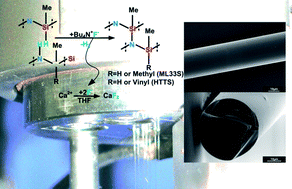Selective cross-linking of oligosilazanes to tailored meltable polysilazanes for the processing of ceramic SiCN fibres
Abstract
An interesting alternative for the processing of non-oxide ceramic fibres at lower costs than that for the current commercially available fibre types was developed by modifying different commercially available liquid oligosilazanes (ML33 and HTT1800) into polysilazanes by selective cross-linking via the N–H and Si–H groups with tetra-n-butylammoniumfluoride (TBAF) as a catalyst. Termination of the reaction with calcium borohydride allows the processing of meltable solid polysilazanes (ML33S and HTTS) with tailored chemical and thermal properties, to fulfil the requirements for the melt spinning of mechanically stable and homogeneous polymeric fibres. The chemical and thermal stability of the polysilazanes ML33S and HTTS were investigated by using GPC, DSC and rheological measurements. These techniques indicate the dependency of the molecular weight and glass temperature on the catalytical cross-linking conditions. Polymers with up to ∼10 000 g mol−1 show glass–liquid transition (Tg) between 65 and 81 °C and viscoelasticity, which are essential properties for the melt-spinning process. The thermal stability of ML33S is ensured up to 220 °C. In contrast the thermal stability of HTTS is limited to 170 °C due to the presence of vinyl-groups. The viscoelastic behaviour of the polymer melts, measured by oscillatory rheometry, and the sufficient thermal stability allowed the continuous processing of stable green fibres by melt spinning in the temperature range of 110 to 130 °C. After fast electron beam irradiation curing of the green fibres and pyrolysis of continuous amorphous ceramic SiCN fibres from both ML33S and HTTS polysilazanes were successfully synthesized, while a defined Tg point influences the shape and the smoothness positively.


 Please wait while we load your content...
Please wait while we load your content...